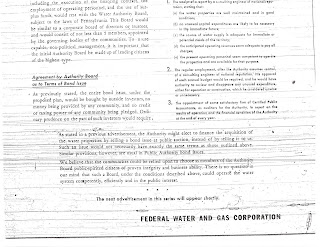Between March 19th and April 17th 1945 a series of nine (9) full page "advertisements" were placed in The Scranton Times newspaper by the FEDERAL WATER AND GAS CORPORATION to (presumably) inform "communities" of their options to either "buy"
The Scranton-Spring Brook Water System or "continue to pay rent (so to speak) to an outside owner". Of particular importance in this series was Ad No. 8,
A Modern Public Authority Combines Two Sound Principles:
1st Principle - Revenue Bonds
Water revenue bonds were first issued in the United States nearly 50 years ago. Water Authority issues today customarily require that the revenues of the project acquired or built with the proceeds of the bonds be segregated from other municipal revenues. They also require that the Authority itself be segregated from other municipal operations, so that its revenues will not be mingled with other public funds and its management will not be distracted by demands other than those of the operation of its business.
2nd Principle - Separation of Functions
The Authorities are separately organized and operate along business lines. Municipal officials appoint the members of the Boards of the Authorities. But after the members of a Board have been appointed their functions are similar to those of a board of directors of a private corporation, which establishes the policies of the organization and directs that they be carried out by the operating personnel.
An Authority ordinarily is given wide powers to accomplish its purpose. Members of the Authority Board are ordinarily selected for their business experience. In most cases little or no compensation is paid the appointees. They should be comparatively free from political influences.





































<< Home